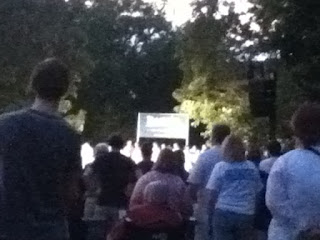The City of Cedar Rapids is converting a number of its one-way streets in the downtown area and surrounding neighborhoods to two-way... or more precisely, back to two-way, since all of these streets used to be two-way back in the day. The process is being implemented gradually; additional street conversions are planned over the next five years, including the 2nd-3rd Avenue pair, the 4th-5th Avenue pair and the 7th-8th Street pair (only from 4th Avenue out). 3rd Avenue in particular will feature pedestrian areas and protected bike lanes, and numerous intersections are switching from traffic signals to four-way stops.
 | |
| 3rd Avenue SE at the entrance of Redmond Park; by 2020 this will be one lane each way |
The city states four goals for the effort:
- make the streets accessible and easier to navigate
- improve opportunities to walk or bike [BN: I know bikers who will dispute this]
- increase visibility of downtown businesses
- slow traffic
There seems to be consensus that one-way streets are efficient means of moving automobile traffic through an area--limited-access highways being the quintessential example. That was indeed the purpose of converting city streets to one-way, beginning in the 1950s. That goal is enough justification for some people, but experience has shown adverse effects on pedestrian safety, business viability, and residential neighborhood comfort. For instance, along several miles of one-way streets in Cedar Rapids there is not a single successful commercial area (possibly excepting the Oakland Road Hy-Vee) and the remaining residential areas (in Mound View, Wellington Heights and the Taylor Area) are struggling.
Planner and author Jeff Speck summarizes:
One-ways wreck downtown retail districts for reasons beyond [faster and more aggressive] driving, principally because they distribute vitality unevenly, and often in unexpected ways. They have been known to kill stores consigned to the morning path to work, since people do most of their shopping on the evening path home. They also increase a situation in which half the stores on cross-streets lose their retail visibility, being located over the shoulders of passing drivers. They intimidate out-of-towners, who are afraid of becoming lost, and they frustrate locals, who are annoyed by all the circular motions and additional traffic lights they must pass through to reach their destinations. (Walkable City: How Downtown Can Save America, One Step at a Time, Farrar Straus Giroux, 2012, pp. 179)Speck cites the experience of Savannah, Georgia, which lost 2/3 of taxpaying addresses along East Broad Street after it was converted to one-way in 1969, but regained most of them after it was converted back to two-way (2012: 180). Can Cedar Rapids expect a similar transformation? Past experience is no guarantee of future results, but really, the conditions through which these one-ways run mean there's not much to lose by trying.
Criticisms of Cedar Rapids's one-way to two-way conversion fall along two lines. The first expects disastrous effects on auto traffic: more traffic jams, more accidents, and in general downtown becoming a frustrating tangle. In part this is informed by a viewpoint that privileges auto travel, as well as a view of downtown as a place to drive to, park ideally for free, do something and leave (which I do, too, but is economically unsustainable if that's all it is). But there's also this point: the places created by improving commercial and residential conditions are at the same time situated along paths to get to and from other locations. The conversions of 2nd and 3rd Avenues might divert more traffic to 1st and 8th Avenues, which can probably take more. But if 1st and 8th are road-dieted, then what happens? This bears watching.
 |
| 4th Avenue SE before conversion to two-way: Will conversion help stimulate development? |
 |
| 4th Avenue today. Tomorrow? |
Ultimately, though, the one-way to two-way conversion project needs to do more than not cause harm. This is a lot of effort to go to if we end up with the same downtown except for different, slower auto traffic patterns plus some bike lanes. The conversion project will be a success only if it contributes to the transformation of downtown.
David Sucher writes, in City Comforts: How to Build an Urban Village (City Comforts Inc., rev. ed., 2003, p. 86), if one's goal is to move as many cars as possible through a neighborhood, the couplet [of one-way streets] works well. But if the goal is to create comfortable shopping districts, make streets two-way. The conversion will be a success if it facilitates transformation of the city center into a 24-hour downtown, with a successful commercial enterprises, permanent residents and cultural attractions all contributing to a vibrant place. This would be a lot different from what's there now, albeit there have been some important seeds planted. Conversion doesn't guarantee transformation--a lot depends on how surrounding areas (particularly the MedQuarter) develop, the emergence of entrepreneurs, and favorable overall economic and social conditions. (For more on what makes a neighborhood or downtown area walkable, see Susan Henderson, "Walkability: It's Not About the Buildings or Even the Streets, It's About the Experience," Place Shakers, 14 September 2015). But time and experience have shown that the couplet never gets this done.
Why get it done at all? Is it any more than the preferences of one set of people being imposed on others? To some degree, urban living and bicycling and such are more popular than they were a generation ago. We shouldn't build our cities to exclude those choices, but to enable the broadest set of choices possible. Even more critically, the environment, public health, and city finances simply cannot stand another generation of development like the last two. We have to do things differently, and we have to do them in city centers.






























